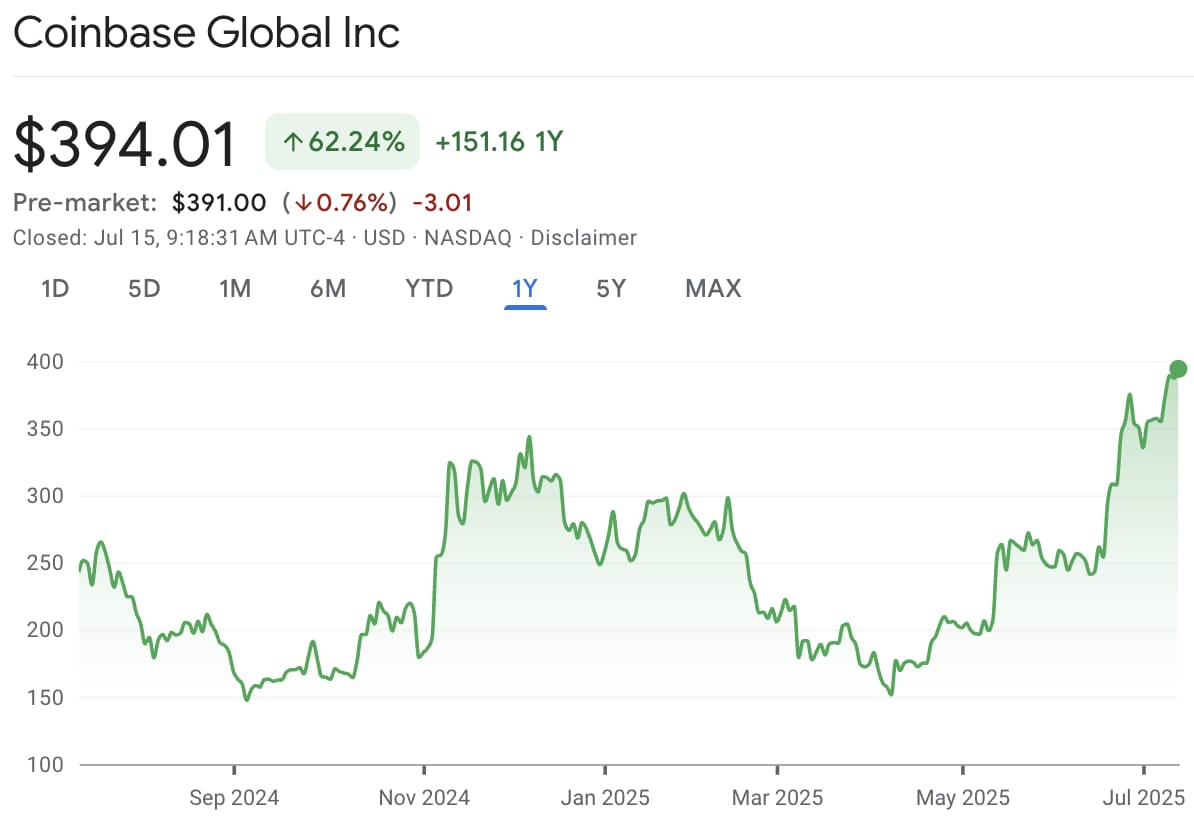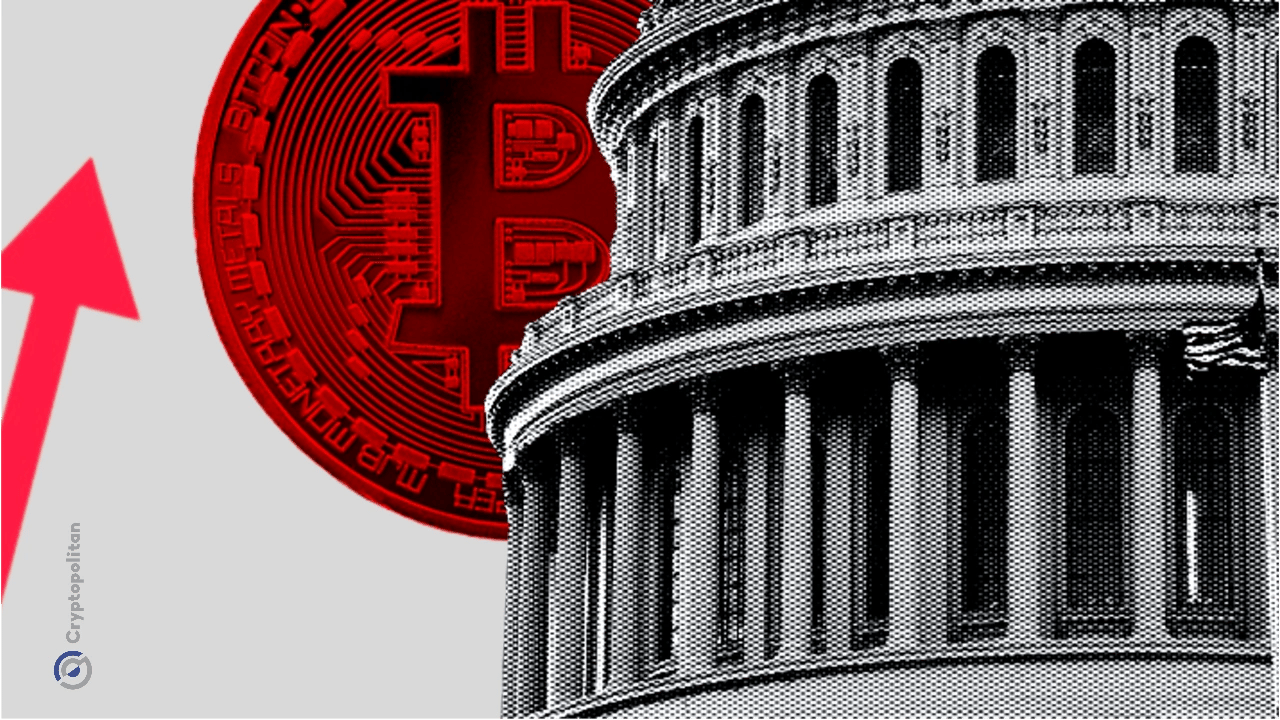- Cryptopolitan
- Posts
- Coinbase hits $100B, XRP gets its ETF moment, and banks face new crypto rules
Coinbase hits $100B, XRP gets its ETF moment, and banks face new crypto rules
From ETFs to stablecoin regulation, the system is shifting and Coinbase is riding the wave. XRP breaks out, banks get stricter custody rules, and ETH quietly dominates treasuries.
🚀 Coinbase just hit $100B and it's only the beginning
Coinbase is having its biggest moment since going public.
This week, the company’s market cap surged past $100 billion, with shares hitting a peak of $398.50 and closing at $394.01, the highest valuation in its history. That’s a 50% jump in just the past month.
The rally isn’t just a reaction to Bitcoin’s new highs. It’s a signal that Coinbase is becoming something far bigger: crypto’s default gateway to Wall Street.
How did we get here?
Two catalysts converged in the past 30 days. First, Coinbase was officially added to the S&P 500, a historic milestone for a crypto-native company.
Second, Circle’s IPO and renewed institutional flows into ETFs brought Wall Street cash pouring back into digital assets. Coinbase became the easiest, most compliant way to get exposure.
While most still think of Coinbase as a trading platform, the real story is under the hood.
Stablecoins are now the moneymaker
In Q1, Coinbase pulled in $772 million in revenue, with a growing share coming from stablecoins, not trading fees.
This aligns perfectly with where U.S. policy is headed. A stablecoin regulation bill is being pushed through Congress this week, and it has bipartisan momentum.
If passed, it could solidify Coinbase’s role as the U.S. stablecoin bank, giving it predictable, high-margin income.
Is $1 trillion realistic?

Bitwise CIO Matt Hougan thinks so. Back in May, he pointed to Coinbase as the one sub-$100B company with the clearest path to a trillion-dollar valuation.
Why? Because it’s now a platform, not just an exchange.
Passive ETF flows, regulated stablecoin revenue, and deep political connections including ties to Trump’s pro-crypto camp mean Coinbase is no longer just reacting to markets. It’s helping shape them.
Meanwhile, in Washington…
This week marks the start of “Crypto Week” in Congress, with three major bills up for vote:
Regulation for dollar-backed stablecoins
Market structure framework for crypto assets
A ban on Fed-issued CBDCs
Each of these bills reduces uncertainty and Coinbase is positioned to benefit from all three.
Analysts say Coinbase could become the BlackRock of crypto, once these guardrails are fully in place.
What this means for the industry
Coinbase's rise tells us something bigger is happening.
The narrative is shifting. Crypto isn’t just back, it’s becoming part of the financial system. And Coinbase, with its regulatory lead, is likely to be the first company to take that story to a trillion.
If you had doubts about mainstream adoption, this should settle it.
The race to accumulate Ether as a treasury asset is heating up with more than ten companies buying 550,000 ETH worth $1.65 billion in the last 30 days.
📈 Market Watch
After months of lagging behind the majors, XRP finally had its breakout moment.
On Tuesday, XRP spiked to $2.92, breaking out of its $2.80 range, after the NYSE Arca approved the ProShares Ultra XRP ETF: a leveraged product offering 2x exposure to XRP’s price movements.
This marks the first U.S.-based ETF approval directly tied to XRP, even though it doesn’t hold the asset itself.
Why it moved
The approval came with immediate effect under the Securities Exchange Act of 1934, allowing ProShares to list the ETF under the ticker UXRP. The ETF tracks the Bloomberg XRP Index and targets 2x daily returns, appealing to institutional and high-frequency traders.
Importantly, the fund won’t hold XRP directly, so it doesn’t create buying pressure like spot ETFs.
Still, the market took the approval as a major regulatory signal.
What’s different this time?
This isn’t XRP's first flirtation with ETF talk.But now, it’s being treated seriously.
Just days ago, the XXRP ETF quietly crossed $165 million AUM, showing that demand for XRP exposure is real, even in leveraged form.
XRP’s breakout is more than just a chart move. It signals renewed confidence in the asset’s institutional future, after years of being sidelined by SEC litigation.
What’s ahead?
A string of ETF decisions is coming this month:
Turtle Capital XRP ETF – decision expected July 16
Rex-Osprey XRP ETF – approval deadline July 25
Truth Social XRP ETF – pending review
More than 19 XRP-based ETFs are in various stages of filing, with some expected to seek spot approval if momentum holds.
If any one of them gets the green light, XRP could finally reclaim its pre-lawsuit glory and possibly break its all-time high.
On July 15, Standard Chartered began offering institutional spot trading for Bitcoin (BTC/USD) and Ether (ETH/USD) through its UK branch.
🏛️ Regulation Watch
Banks offering crypto custody services just received a clear message: treat crypto like a serious asset or face the consequences.
For the first time, federal agencies have outlined exactly how banks should manage the risks of holding digital assets. This includes how they work with third-party providers, handle key storage, and set up internal audits.
Key requirements now expected from banks:
Understand custody chains: Banks must evaluate sub-custodians — the third parties that actually hold crypto and assess what happens if they go bankrupt or experience disruptions.
Secure key management: They need to track how crypto keys are created, stored, and deleted, whether in-house or via a tech vendor.
Evaluate tech risks: Even if a bank uses someone else’s software or hardware, it must assess whether it's safer to build its own or buy existing tools.
Set up crypto-specific audits: General IT checks aren't enough. Banks now need audits tailored to crypto, including reviewing security systems and employee readiness.
Bring in external experts: If banks lack the skills internally, regulators expect them to hire independent crypto professionals to validate operations.
Why it matters:
These new rules make it harder for banks to offer crypto custody but safer for customers.
The push for stricter oversight aligns with the broader U.S. effort to normalize digital assets inside the financial system. With major crypto bills approaching in Congress, secure custody is becoming a non-negotiable foundation.
📚 Read Also: Wall Street’s BlackRock, JPMorgan, Wells Fargo and Citi post record-shattering earnings
Wall Street’s top banks just posted second-quarter numbers that blew the lid off estimates, per financial reports reviewed by Cryptopolitan.
🔵 Stories you may have missed
Fed’s Kevin Warsh does a full U-turn on rate cuts as he looks to take Powell’s job: Kevin Warsh now supports rate cuts and shrinking the Fed’s balance sheet as he campaigns to replace Jerome Powell.
Russia mocks Trump for sanctions threat, calls him ‘theatrical’: On Tuesday, a senior Russian security official told reporters that Moscow doesn’t care about the U.S. president’s plan to punish countries buying Russian exports with 100% tariffs.
Influencer Crypto Beast directs blame to snipers after Altcoin’s ALT crash rug pull: A recently promoted token, Altcoin (ALT), suffered a rug pull, erasing over 95% of its value.
Is it too late for Japan to rescue its economy?: Japan’s bond market is falling apart in real time. On Tuesday, long-term government yields quietly hit levels not seen before.
Popular Hyperliquid trader James Wynn is back, moves to USDC and PEPE: The popular Hyperliquid trader James Wynn has returned to the market with a 10x leveraged PEPE position after weeks of silence.
The Federal Reserve has implemented ISO20022 for Fedwire to improve cross-border payments: Fedwire, the central bank’s real-time gross settlement system, processes approximately $4.7 trillion in payments daily.
Shiba Inu unveils identity system to defend user data from quantum computing threats: The memecoin project Shiba Inu is working on a privacy-focused Shib Identity to address the risk of quantum computing.

15th July
On July 15, 2020, a coordinated hack took over 69 high-profile Twitter accounts, including those of Elon Musk, Barack Obama, Bill Gates, Apple, and others, to post a seemingly generous Bitcoin scam:
“We are giving back to our community… send BTC to this address and we’ll double it!”
Join the Conversation!
We'd love to hear your thoughts and comments. Join our community and stay updated with the latest trends and discussions in crypto.
Twitter: @CPOfficialtx
Telegram Channel: @CryptopolitanOfficial
Beehiiv: https://cryptopolitan.beehiiv.com/
Facebook: https://www.facebook.com/cryptopolitan


